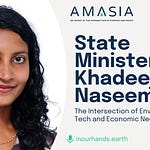In this episode of In Our Hands, Ramanan Raghavendran speaks with Bjarne Pedersen, Executive Director for Clean Air Asia. They discuss the link between air quality and climate change, the main sources of air pollution in Asian cities, the role of electric vehicles in reducing emissions, the importance of data collection, and the power of partnerships in driving air quality reform.
For a full episode transcript, click the transcript button. This episode is also available on Apple Podcasts and Spotify.
In Our Hands is a production of Amasia. Follow these links for more about our firm, the Amasia blog, our climate fiction podcast, and Ramanan’s blog.
Highlights
(02:25) The Connection Between Air Pollution and Climate Change
(04:57) Challenges and Solutions for Air Pollution in Asian Cities
(12:25) The Impact of Data on Air Pollution Management
(17:44) How Partnerships Tackle Complex Issues
(18:28) NGO Initiatives to Combat Pollution and Promote Electric Vehicles
(22:01) Strategies for Galvanizing Public Support for Air Quality Reform
(25:32) Launching a Regional Knowledge Exchange Initiative











